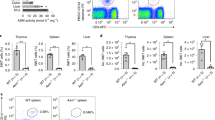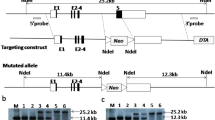Abstract
Glycosphingolipids (GSL) are natural ligands of NKT cells. Several laboratories have reported the in vitro activity of isoglobotriosylceramide (iGb3) in stimulating NKT cells. However, the knockout mice of iGb3 synthase showed no deficiency in development and function of NKT cells. There is a lack of knowledge on the genetics of redundant natural glycosphingolipid ligands. We have identified additional glycosphingolipid with stimulatory activity to NKT cells, including fucosyl lactosylceramide (H antigen). Here we describe the procedures to generate mice with deficiencies in Fut1, Fut2, and Sec1 genes to deplete H antigen through BAC engineering for the generation of ES cell-targeting construct, as well as the mice with deficiency of both blood group H-GSL ligand and isoglobotriosylceramide.
Access this chapter
Tax calculation will be finalised at checkout
Purchases are for personal use only
Similar content being viewed by others
Abbreviations
- Blood group A:
-
GalNAc α3 Fuc α2 Gal β
- Blood group B:
-
Gal α3 Fuc α2 Gal β
- Blood group H:
-
Fuc α2 Gal β
- CFG :
-
Consortium of functional glycomics
- Fut1:
-
α-2 fucosyltransferase I
- Fut2 :
-
α-2 fucosyltransferase II
- NKT:
-
natural killer T cells
- Sec1:
-
α-2 fucosyltransferase III
References
Kronenberg M (2005) Toward an understanding of NKT cell biology: progress and paradoxes. Annu Rev Immunol 23:877–900
De Libero G, Mori L (2005) Recognition of lipid antigens by T cells. Nat Rev Immunol 5:485–496
Van Kaer L (2005) α-Galactosylceramide therapy for autoimmune diseases: prospects and obstacles. Nat Rev Immunol 5:31–42
Porcelli SA, Modlin RL (1999) The CD1 system: antigen-presenting molecules for T cell recognition of lipids and glycolipids. Annu Rev Immunol 17:297–329
Godfrey DI, MacDonald HR, Kronenberg M, Smyth MJ, Van Kaer L (2004) NKT cells: what’s in a name? Nat Rev Immunol 4:231–237
Taniguchi M, Harada M, Kojo S, Nakayama T, Wakao H (2003) The regulatory role of Va14 NKT cells in innate and acquired immune response. Annu Rev Immunol 21:483–513
Major AS, Van Kaer L (2005) The role of natural killer T cells in atherosclerosis. Curr Immunol Rev 1:261–274
Natori T, Koezuka Y, Higa T (1993) Agelasphins, novel a-galactosylceramides from the marine sponge Agelas mauritianus. Tetrahedron Lett 34:5591–5592
Kawano T, Cui J, Koezuka Y, Toura I, Kaneko Y, Motoki K, Ueno H, Nakagawa R, Sato H, Kondo E, Koseki H, Taniguchi M (1997) CD1d-restricted and TCR-mediated activation of Vα14 NKT cells by glycosylceramides. Science 278:1626–1629
Mattner J, Debord KL, Ismail N, Goff RD, Cantu C 3rd, Zhou D, Saint-Mezard P, Wang V, Gao Y, Yin N, Hoebe K, Schneewind O, Walker D, Beutler B, Teyton L, Savage PB, Bendelac A (2005) Exogenous and endogenous glycolipid antigens activate NKT cells during microbial infections. Nature 434(7032):525–529
Kinjo Y, Wu D, Kim G, Xing GW, Poles MA, Ho DD, Tsuji M, Kawahara K, Wong CH, Kronenberg M (2005) Recognition of bacterial glycosphingolipids by natural killer T cells. Nature 434(7032):520–525
Sriram V, Du W, Gervay-Hague J, Brutkiewicz RR (2005) Cell wall glycosphingolipids of Sphingomonas paucimobilis are CD1d-specific ligands for NKT cells. Eur J Immunol 35(6):1692–1701
Zhou D et al (2004) Lysosomal glycosphingolipid recognition by NKT cells. Science 306:1786–1789
Porubsky S et al (2007) Normal development and function of invariant natural killer T cells in mice with isoglobotrihexosylceramide (iGb3) deficiency. Proc Natl Acad Sci U S A 104:5977–5982
Speak AO et al (2007) Implications for invariant natural killer T cell ligands due to the restricted presence of isoglobotrihexosylceramide in mammals. Proc Natl Acad Sci U S A 104:5971–5976
Li Y et al (2009) Immunologic glycosphingolipidomics and NKT cell development in mouse thymus. J Proteome Res 8:2740–2751
Li Y et al (2008) Sensitive detection of isoglobo and globo series tetraglycosylceramides in human thymus by ion trap mass spectrometry. Glycobiology 18:158–165; Erratum in: Glycobiology 18, 568 (2008)
Zhou D (2006) The immunological function of iGb3. Curr Protein Pept Sci 7:325–333
Stanic AK et al (2003) Defective presentation of the CD1d1-restricted natural Va14Ja18 NKT lymphocyte antigen caused by beta-D-glucosylceramide synthase deficiency. Proc Natl Acad Sci U S A 100:1849–1854
Brennan PJ et al (2011) Invariant natural killer T cells recognize lipid self antigen induced by microbial danger signals. Nat Immunol 12:1202–1211
Bendelac A (1995) Positive selection of mouse NK1+ T cells by CD1-expressing cortical thymocytes. J Exp Med 182:2091–2096
Chatterjee S, Kolmakova A, Rajesh M (2008) Regulation of lactosylceramide synthase (glucosylceramide beta 1->4 galactosyltransferase); implication as a drug target. Curr Drug Targets 9:272–281
Diswall M, Angström J, Schuurman HJ, Dor FJ, Rydberg L, Breimer ME (2007) Studies on glycolipid antigens in small intestine and pancreas from alpha1,3-galactosyltransferase knockout miniature swine. Transplantation 84(10):1348–1356
Puga Yung GL, Li Y, Borsig L, Millard AL, Karpova MB, Zhou D, Seebach JD (2012) Complete absence of the αGal xenoantigen and isoglobotrihexosylceramide in α1,3galactosyltransferase knock-out pigs. Xenotransplantation 19(3):196–206
Holgersson J, Jovall PA, Samuelsson BE, Breimer ME (1990) Structural characterization of non-acid glycosphingolipids in kidneys of single blood group O and A pigs. J Biochem 108(5):766–777
Watkins W (1980) Biochemistry and genetics of the ABO, Lewis, and P blood group systems. Adv Hum Genet 10:1
Clausen H, Hakomori S (1989) ABH and related histo-blood group antigens; immunochemical differences in carrier isotypes and their distribution. Vox Sang 56:1–20
Bell K (1983) Red blood cells of domestic mammals. Elsevier Science Publishers, Amsterdam, pp 133–164
Yamamoto M et al (2001) Murine equivalent of the human histo-blood group ABO gene is a cis-AB gene and encodes a glycosyltransferase with both A and B transferase activity. J Biol Chem 276:13701–13708
Domino SE, Zhang L, Lowe JB (2001) Molecular cloning, genomic mapping, and expression of two secretor blood group alpha (1,2)fucosyltransferase genes differentially regulated in mouse uterine epithelium and gastrointestinal tract. J Biol Chem 276(26):23748–23756
Lin B, Saito M, Sakakibara Y, Hayashi Y, Yanagisawa M, Iwamori M (2001) Characterization of three members of murine alpha1,2-fucosyltransferases: change in the expression of the Se gene in the intestine of mice after administration of microbes. Arch Biochem Biophys 388(2):207–215
Liu Y, Goff RD, Zhou D, Mattner J, Sullivan BA, Khurana A, Cantu C 3rd, Ravkov EV, Ibegbu CC, Altman JD, Teyton L, Bendelac A, Savage PB (2006) A modified alpha-galactosyl ceramide for staining and stimulating natural killer T cells. J Immunol Methods 312(1–2):34–39
Bird AW, Erler A, Fu J, Hériché JK, Maresca M, Zhang Y, Hyman AA, Stewart AF (2011) High-efficiency counter selection recombineering for site-directed mutagenesis in bacterial artificial chromosomes. Nat Methods 9(1):103–109
Lin Z, Li S, Feng C, Yang S, Wang H, Ma D, Zhang J, Gou M, Bu D, Zhang T, Kong X, Wang X, Sarig O, Ren Y, Dai L, Liu H, Zhang J, Li F, Hu Y, Padalon-Brauch G, Vodo D, Zhou F, Chen T, Deng H, Sprecher E, Yang Y, Tan X (2016) Stabilizing mutations of KLHL24 ubiquitin ligase cause loss of keratin 14 and human skin fragility. Nat Genet 48(12):1508–1516
Acknowledgments
This work was supported by US NIH grant AI079232 (DZ), National Key Research and Development Plan grant 2021YFE0200500 and 2017YFA0505901 (DZ), Fundamental Research Funds for the Central Universities 22120210292 (DZ), National Natural Science Foundation of China grant 81570007 and 31870972 (DZ), Shanghai Science and Technology Committee grant 20410713500, and the Outstanding Clinical Discipline Project of Shanghai Pudong Grant Number: PWYgy2018–10 (DZ). All these sponsors have no roles in the study design or the collection, analysis, and interpretation of data.
Author information
Authors and Affiliations
Corresponding authors
Editor information
Editors and Affiliations
1 Electronic Supplementary Materials
Data S1
Primer sites for genotyping of Fut1/Fut2/Sec1 triple KO mice. Sites of PCR primers were marked for genotyping of △ Fut1/+Hyg allele and △Fut2DSec1 + (loxP-neo-loxP) allele (PPTX 38 kb)
Data S2
Stimulatory activities of blood group H GSLs to iNKT cells. iGb3 and blood group GSLs dissolved at 1 mg/mL in DMSO were diluted in cell culture medium at indicated concentrations and pulsed to mouse (C57BL/6) bone marrow-derived dendritic cells (105) for 8 h, after which the dendritic cells were washed with culture medium and mixed with DN32.D3 hybridoma cells (5 × 104). The resulting mixture was co-cultured for 24 h, and the released IL-2 was measured by bioassays using CTLL-2 cell line. Unit means international unit of IL2 (PPT 132 kb)
Data S3
Development of iNKT cells in Fut1/Fut2/Sec1−/− mice and Fut1/Fut2/Sec1/A3galt2−/− mice. Lymphocytes were purified from mouse thymus, spleen, and liver and stained by αGalCer/CD1d tetramer (APC-labelled, provided by NIAID tetramer facility at Emory University, Atlanta, GA) at cell surface, followed by staining with anti-CD3 antibody. % means the percentage of CD3+ PBS57/CD1d tetramer+ NKT cells among total CD3+ T cells. (A and B) Fut1/Fut2/Sec1−/− mice and wild-type littermates. (C and D) Fut1/Fut2/Sec1/A3galt2−/− mice and wild-type littermates (PPTX 550 kb)
Data S4
(DOCX 21 kb)
Data S5
(PPT 693 kb)
Rights and permissions
Copyright information
© 2021 The Author(s), under exclusive license to Springer Science+Business Media, LLC, part of Springer Nature
About this protocol
Cite this protocol
Zhou, D. et al. (2021). Genetic Studies of Natural Glycosphingolipid Ligands for NKT Cells. In: Liu, C. (eds) Invariant Natural Killer T-Cells. Methods in Molecular Biology, vol 2388. Humana, New York, NY. https://doi.org/10.1007/978-1-0716-1775-5_2
Download citation
DOI: https://doi.org/10.1007/978-1-0716-1775-5_2
Published:
Publisher Name: Humana, New York, NY
Print ISBN: 978-1-0716-1774-8
Online ISBN: 978-1-0716-1775-5
eBook Packages: Springer Protocols




